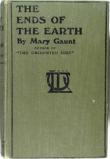AustLit
Latest Issues
Contents
- A Scrap of Autobiography, single work autobiography (p. v-ix)
- The Doctor's Drive, single work short story (p. 1-10)
- The Ways of God, single work short story (p. 11-24)
- When the Colt Jammed, single work short story (p. 25-33)
- The First Australian Love Story, single work short story (p. 35-47)
- The Humbling of Sergeant Mahone, single work short story (p. 49-60)
- The Cost of the Boat, single work short story (p. 61-74)
- Peter Addie and the Ju-Ju, single work short story (p. 75-89)
-
A Dilemma
For Old Sake's Sake,
single work
short story
(p. 91-98)
Note: With title: A Dilemma
- Sweetbriar in the Desert, single work short story (p. 99-111)
- Roger Blake, Scallawag, single work short story (p. 113-135)
- The Dire Peril of Sergeant Sells, single work short story (p. 137-150)
- A Good Samaritan, single work short story (p. 151-157)
- The Mate's Salvage, single work short story (p. 159-176)
- The Woman Who Did Not Care, single work short story (p. 177-207)
-
Vermisst
The Lost White Woman,
single work
short story
(p. 209-217)
Following a shipwreck of a vessel headed to Sydney, Ellen Hammond is stranded with three men on the Gippsland Coast. In the night, the men are murdered by a group of Aboriginal men but she is spared and brought back to their camp.
The perspective switches to Ellen's husband, Tom Hammond, who insists to the police captain on coming along to search for Ellen, who has been leaving "E.H." scratched into trees. They track the group of Aboriginal people and creep up on their camp before storming it. In the confusion and chaos, a shot is let loose against the orders of the police captain. Ellen is found beside the fire - dying, from the fired shot. In the aftermath, the captain is certain that it was Tom Hammond himself who fired the bullet that ended up killing his wife, but they decide to keep it quiet, believing that Ellen was better off dead after what she had experienced.
Note: With title: The Lost White Woman. - "North of 53", single work short story (p. 219-237)
Publication Details of Only Known VersionEarliest 2 Known Versions of
Other Formats
- Also e-book.
Works about this Work
-
Mary Gaunt and the Modern Waning of Affect
2012
single work
criticism
— Appears in: JASAL , vol. 12 no. 1 2012; 'Prolific author and inveterate traveller Mary Gaunt (1865-1942) embodied and enacted her ideal of the enterprising white colonial woman in her three texts on Jamaica, including two works of non-fiction: a history titled Where the Twain Meet (1920); a travel book titled In Jamaica: Reflections (1932), and one historical novel titled Harmony (1933). The white colonial subject she celebrates is, in her view, best equipped to exploit the unrealised potential of Jamaica because of her particular mobility through the metropole and across the dominions of empire. This mobility also situates the colonial in time as a resolutely modern subject, one who is not locked in the past but attuned to the present and the future.
This paper argues, however, that the colonial's seeming capacity to align the spaces and times of modernity is arrested in Gaunt's writing by her performance of disregulated affect and a failure of sympathy. Her writing explicitly constructs a writing subject caught between the conventions of literary transport and the actual transport of her travels in ways that position her as too close to, or too distant from, people and place. This paper will first identify a range of these misalignments in Gaunt's work and then consider them as indicative of a dilemma at the heart of modern fiction, and of the reading subject of modernity more generally.' (Author's abstract)
-
[Review] The Ends of the Earth
1916
single work
review
— Appears in: The Bulletin , 2 March vol. 37 no. 1881 1916; (p. 2)
— Review of The Ends of the Earth : Stories 1916 selected work short story
-
[Review] The Ends of the Earth
1916
single work
review
— Appears in: The Bulletin , 2 March vol. 37 no. 1881 1916; (p. 2)
— Review of The Ends of the Earth : Stories 1916 selected work short story -
Mary Gaunt and the Modern Waning of Affect
2012
single work
criticism
— Appears in: JASAL , vol. 12 no. 1 2012; 'Prolific author and inveterate traveller Mary Gaunt (1865-1942) embodied and enacted her ideal of the enterprising white colonial woman in her three texts on Jamaica, including two works of non-fiction: a history titled Where the Twain Meet (1920); a travel book titled In Jamaica: Reflections (1932), and one historical novel titled Harmony (1933). The white colonial subject she celebrates is, in her view, best equipped to exploit the unrealised potential of Jamaica because of her particular mobility through the metropole and across the dominions of empire. This mobility also situates the colonial in time as a resolutely modern subject, one who is not locked in the past but attuned to the present and the future.
This paper argues, however, that the colonial's seeming capacity to align the spaces and times of modernity is arrested in Gaunt's writing by her performance of disregulated affect and a failure of sympathy. Her writing explicitly constructs a writing subject caught between the conventions of literary transport and the actual transport of her travels in ways that position her as too close to, or too distant from, people and place. This paper will first identify a range of these misalignments in Gaunt's work and then consider them as indicative of a dilemma at the heart of modern fiction, and of the reading subject of modernity more generally.' (Author's abstract)




